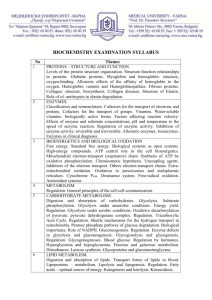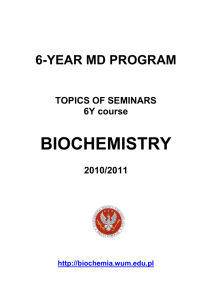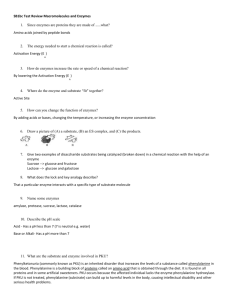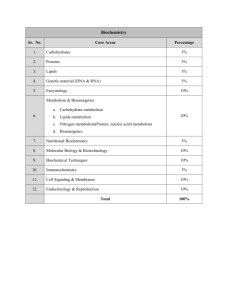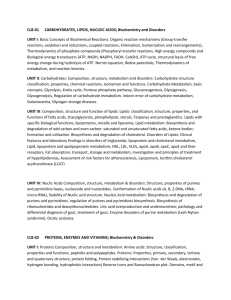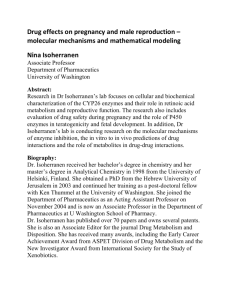Biochemistry
advertisement
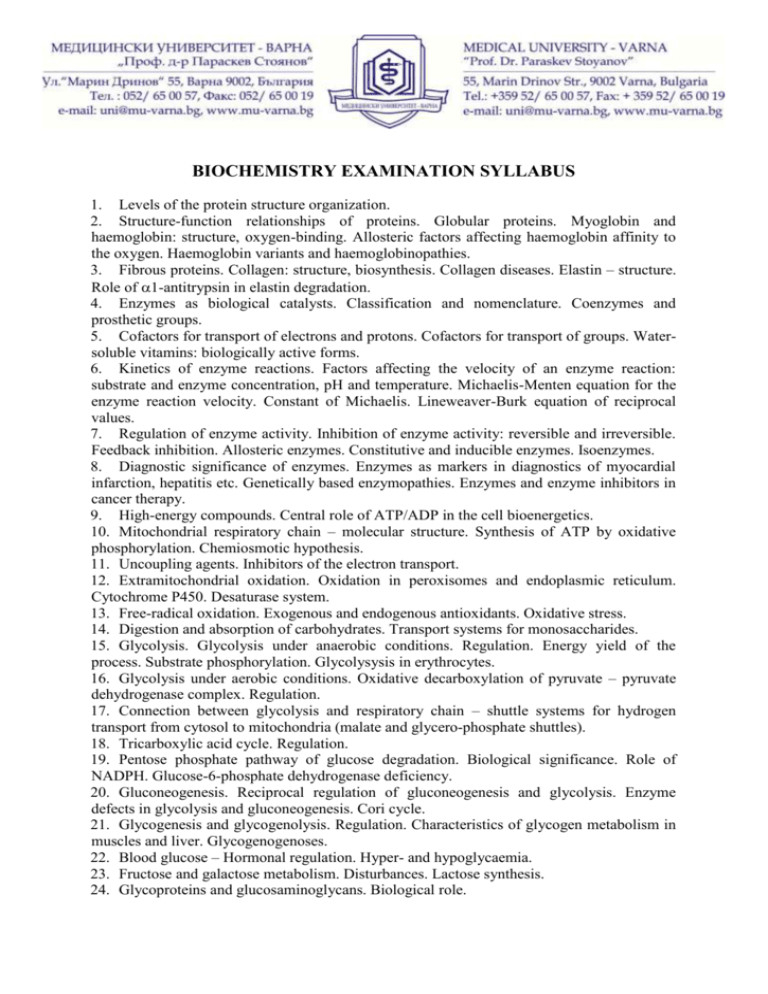
BIOCHEMISTRY EXAMINATION SYLLABUS 1. Levels of the protein structure organization. 2. Structure-function relationships of proteins. Globular proteins. Myoglobin and haemoglobin: structure, oxygen-binding. Allosteric factors affecting haemoglobin affinity to the oxygen. Haemoglobin variants and haemoglobinopathies. 3. Fibrous proteins. Collagen: structure, biosynthesis. Collagen diseases. Elastin – structure. Role of 1-antitrypsin in elastin degradation. 4. Enzymes as biological catalysts. Classification and nomenclature. Coenzymes and prosthetic groups. 5. Cofactors for transport of electrons and protons. Cofactors for transport of groups. Watersoluble vitamins: biologically active forms. 6. Kinetics of enzyme reactions. Factors affecting the velocity of an enzyme reaction: substrate and enzyme concentration, рН and temperature. Michaelis-Menten equation for the enzyme reaction velocity. Constant of Michaelis. Lineweaver-Burk equation of reciprocal values. 7. Regulation of enzyme activity. Inhibition of enzyme activity: reversible and irreversible. Feedback inhibition. Allosteric enzymes. Constitutive and inducible enzymes. Isoenzymes. 8. Diagnostic significance of enzymes. Enzymes as markers in diagnostics of myocardial infarction, hepatitis etc. Genetically based enzymopathies. Enzymes and enzyme inhibitors in cancer therapy. 9. High-energy compounds. Central role of ATP/ADP in the cell bioenergetics. 10. Mitochondrial respiratory chain – molecular structure. Synthesis of ATP by oxidative phosphorylation. Chemiosmotic hypothesis. 11. Uncoupling agents. Inhibitors of the electron transport. 12. Extramitochondrial oxidation. Oxidation in peroxisomes and endoplasmic reticulum. Cytochrome P450. Desaturase system. 13. Free-radical oxidation. Exogenous and endogenous antioxidants. Oxidative stress. 14. Digestion and absorption of carbohydrates. Transport systems for monosaccharides. 15. Glycolysis. Glycolysis under anaerobic conditions. Regulation. Energy yield of the process. Substrate phosphorylation. Glycolysysis in erythrocytes. 16. Glycolysis under aerobic conditions. Oxidative decarboxylation of pyruvate – pyruvate dehydrogenase complex. Regulation. 17. Connection between glycolysis and respiratory chain – shuttle systems for hydrogen transport from cytosol to mitochondria (malate and glycero-phosphate shuttles). 18. Tricarboxylic acid cycle. Regulation. 19. Pentose phosphate pathway of glucose degradation. Biological significance. Role of NADPH. Glucose-6-phosphate dehydrogenase deficiency. 20. Gluconeogenesis. Reciprocal regulation of gluconeogenesis and glycolysis. Enzyme defects in glycolysis and gluconeogenesis. Cori cycle. 21. Glycogenesis and glycogenolysis. Regulation. Characteristics of glycogen metabolism in muscles and liver. Glycogenogenoses. 22. Blood glucose – Hormonal regulation. Hyper- and hypoglycaemia. 23. Fructose and galactose metabolism. Disturbances. Lactose synthesis. 24. Glycoproteins and glucosaminoglycans. Biological role. 25. Digestion and absorption of lipids. Role of chylomicrons for transport of exogenous lipids. 26. Transport forms of lipids in blood. Lipoprotein complexes – types, composition and metabolism. Clinical aspects of lipoproteins metabolism. 27. Lipolysis and lipogenesis. Regulation. Hormone-sensitive lipase. Metabolism of glycerol. 28. Biosynthesis of fatty acids and triacylglycerols. Transport of endogenous lipids. 29. Fatty acids – optimal source of energy. Oxidation of fatty acids. Energetic yield of βoxidation. 30. Ketogenesis and ketolysis – physiological role of ketone bodies. Ketonemia and ketonuria. Ketoacidosis in starvation and diabetes. 31. Cholesterol metabolism. Regulation. Significance of LDL and HDL for the cholesterol metabolism. Cholesterol as a source of compounds with important biological functions. 32. Bile acids and bile salts. Enterohepatic circulation of bile acids. 33. Synthesis of steroid hormones. 34. Phosphoglycerides and glycosphingolipids – forms, biosynthesis and degradation. Biological role. 35. Eicosanoids. Types, biological role. Pathways for obtaining of eicosanoids. Inhibition of prostaglandin synthesis by steroidal and nonsteroidal anti-inflammatory drugs. 36. Degradation of proteins. Intracellular degradation of proteins. Digestion of proteins. Absorption of amino acids. 37. Catabolism of amino acids. Release of the amino acids nitrogen. 38. Ammoniogenesis. Toxicity of ammonia. 39. Ways for disposal of ammonia – role of the liver, muscles and kidneys. Biosynthesis of urea. 40. Decarboxylation of -amino acids. Biogenic amines. Polyamines. 41. Catabolism of the carbon skeleton of amino acids. Role of folic acid in amino acid metabolism. 42. Branched-chain amino acids metabolism. 43. Catabolism of phenylalanine and tyrosine – phenylketonuria, tyrosinosis, albinism, alcaptonuria. 44. Catabolism of tryptophan. 45. Conversion of amino acids to specialized products: catecholamines, thyroid hormones, melatonin, serotonin, creatine, histamine. 46. Heme biosynthesis. Porphyrias and porphyrinurias. 47. Heme degradation. Bile pigments – bilirubin metabolism. Jaundice. 48. Iron metabolism. Iron-binding proteins. Mechanisms for entering of iron in cells. Transport of iron. Disturbances in iron homeostasis – iron-deficiency anemia and iron overloading. 49. Metabolism of purine nucleotides. Hyperuricaemia, Lesch-Nyhan syndrome, immunodeficiency conditions related to purine metabolism disturbances. 50. Metabolism of pyrimidine nucleotides. Hereditary orotate atsiduria. 51. Biosynthesis of deoxyribonucleotides and thymidine triphosphate. 52. Integration of carbohydrates, lipids, amino acids and nucleotides metabolism. Role of common metabolism and key enzymes. Tissue and organ specificity. Well-fed metabolism and adaptation in fasting and diabetes. 53. Macro- and micronutrients. Nutrigenomics and pharmacogenomics – significance in medicine. 54. Calcium metabolism. Hormonal regulation of calcium metabolism: parathyroid hormone, calcitonin. Synthesis of vitamin D. 55. Xenobiotics and endobiotics – mechanisms of biotransformation. Role of cytP450. 56. General principles of the cell-cell communication. Signal molecules, receptors, effector chains. Second messenger – types, formation. 57. Signal transduction by intracellular receptors and ion channel receptors. 58. Transmembrane receptors which generate formation second messengers. Enzyme receptors. Examples for signal transduction by membrane and enzyme receptors. 59. DNA and RNA conformation. Histone and non-histone proteins – significance for DNA conformation maintenance. ‘Histone code’. 60. DNA biosynthesis – regulation of replication. Cell cycle in mammals – molecular mechanisms for cell cycle regulation. Cyclins and cyclin-dependent kinases, p53. Tumour suppressor genes and oncogenes. 61. DNA reparation – mechanisms, enzymes. Genetic defects which can cause disturbances in DNA reparation. 62. RNA biosynthesis – conditional (consensus) model of DNA – sequences acting as promoter. Regulation of transcription. Alternative splicing. Posttranscriptional editing of mRNA. RNA-dependent RNA polymerase. 63. Biosynthesis of proteins – regulation of translation, translational factors (examples). Inhibitors of the protein synthesis. Protein modifications. Protein sorting. RECOMMENDED LITERATURE 1. Champe, P.C., R.A. Harvey. Lippincott's Illustrated Reviews: Biochemistry. J.B. Lippincott's company, 5th Edition, 2011 2. M. A. Lieberman, A. Marks. Marks' Basic Medical Biochemistry: A clinical approach. Williams and Wilkins, 4th Edition, 2013 3. Devlin T. Textbook of Biochemistry with clinical correlations. John Wiley & Sons; 7th Edition, 2010. 4. Murray, R., D. Granner, P. Mayes, V. Rodwell. Harper’s Biochemistry. Lange, 23, 24 or 25 ed. 5. David L. Nelson and Michael M. Cox. Lehninger Principles of Biochemistry, Worth Publishers, New York, 3 ed., 2000. 6. Alberts B., A. Johnson, J. Lewis, and M. Raff. Molecular Biology of the Cell. Garland Science, 5, 4 or 3-rd edition, 2002, 2003 or 2007. 7. Students' own lecture notes


